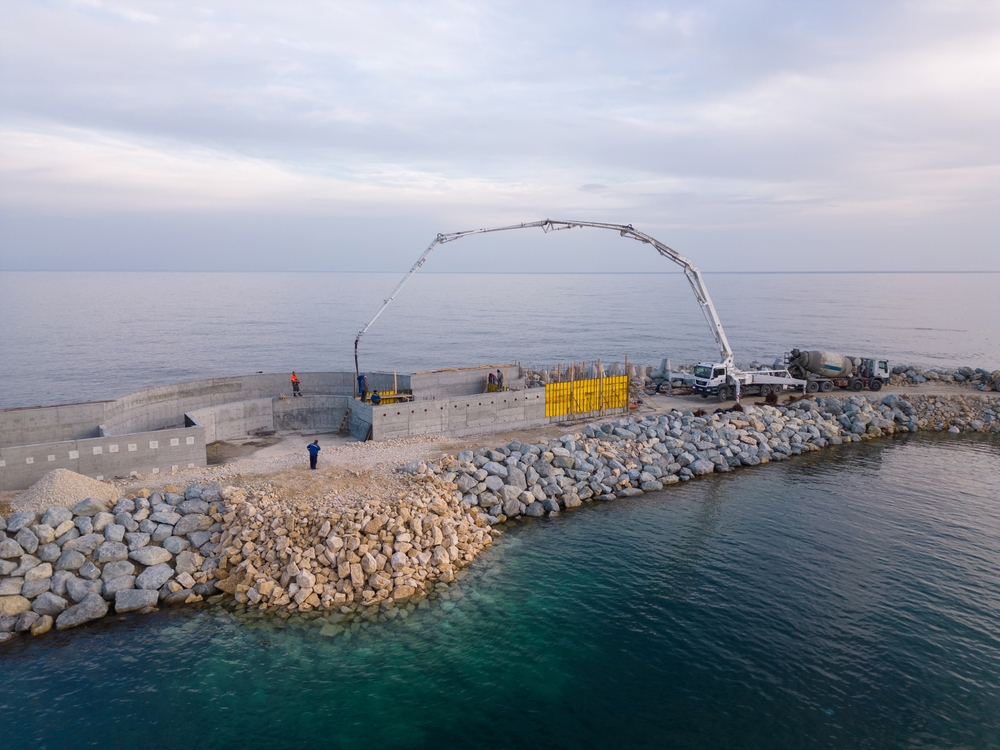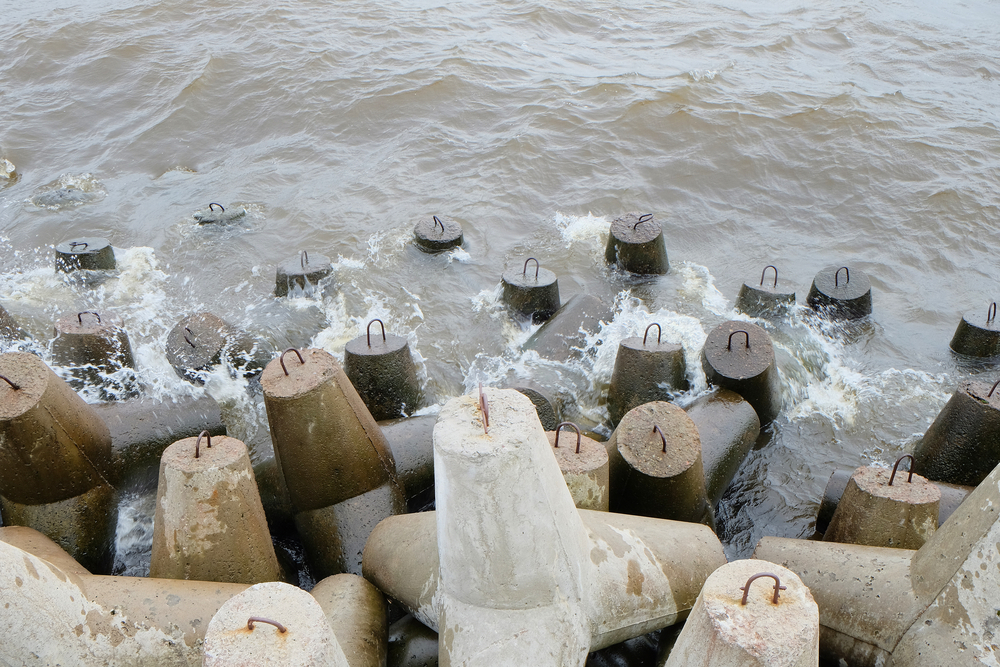Table of Contents
Concrete barriers like seawalls, bulkheads and piers are the front‑line defence for coastal communities. They keep back waves, dissipate storm energy and support vessels, bridges and waterfront facilities. Yet these structures are constantly under assault from saltwater, tides, freeze‑thaw cycles and impacts. Without timely maintenance, seawalls and piers suffer cracking, spalling concrete, settlement and ultimately structural failure. This article examines the top methods used by marine contractors to perform concrete repair for seawalls and pier piles. The goal is to help owners and specifiers understand the causes of deterioration, the tools available for restoring integrity and how to choose the most effective solution.
Why Marine Concrete Deteriorates
Seawalls and piers sit in some of the most aggressive environments on the planet. Their concrete is repeatedly wetted by saltwater, dried by sun and wind, and battered by waves and boats. Constant saltwater exposure introduces chlorides that attack the protective film on reinforcing steel and cause rust. At the same time, temperature swings and wave action create freeze‑thaw cycles and cyclic loading. According to The Dock Experts, surface layers of concrete chip or flake away – a phenomenon called spalling – because these structures are under constant saltwater exposure and structural stress. The article also notes that erosion around the base compromises soil support while hydrostatic pressure trapped behind the wall leads to bulging or cracking. When reinforcement is exposed to seawater, oxidation causes the steel to expand, generating cracks and delamination.
Seawall caps and slabs commonly suffer premature deterioration because of high chloride levels, aggressive wave action and “old age”. The Seawall Savers explain that rusting reinforcement causes concrete to expand, creating fissures in the cap and allowing more chlorides to penetrate. Continuous wetting and drying in the splash zone exacerbates this process. Horizontal cracks often result from hydrostatic pressure pushing behind the wall; once reinforcing steel is exposed, it compromises structural integrity. Soil settlement on the land side can also create voids and sinkholes around bulkheads, pulling soil through cracks as water levels rise and fall. These environmental and loading conditions explain why marine structures demand robust repair strategies.
Assessing Damage: Spalling, Cracks and Structural Issues
Before choosing a repair method, it is essential to identify the type and extent of damage. Spalling concrete appears as flaking or scaling where the surface separates from the underlying material. This is usually accompanied by rust stains, indicating corroded rebar. Cracks can be vertical, diagonal or horizontal. The Seawall Savers note that vertical or diagonal cracks only 1/8 inch wide often result from shrinkage during curing , while cracks wider than 1/2 inch near edges typically indicate deeper structural issues. Horizontal cracks in seawall caps suggest hydrostatic pressure or tieback failure. Bowed or leaning walls reveal foundation instability from soil erosion or inadequate support.
Concrete piles and pier columns require similar assessment. The Pile Medic resource explains that fractures and cracks allow seawater to reach reinforcing steel, accelerating corrosion and causing further spalling. Damage may also include mud intrusion, voids from inconsistent concrete mixes and spalling near the pile head from driving stresses. Accurate diagnosis often relies on non‑destructive testing to measure wall thickness, identify voids and evaluate rebar corrosion.
Damage Types and Recommended Repair Methods
|
Damage type |
Common symptoms |
Primary repair methods |
|---|---|---|
|
Hairline cracks & shrinkage |
Thin vertical/diagonal cracks (< 1/8 in) |
Epoxy crack injection to rebond concrete; sealants for waterproofing |
|
Horizontal cracks & structural fissures |
Spalling, rust stains, cracks wider than 1/2 in; hydrostatic pressure |
Epoxy injection; pressure grouting; helical tiebacks to relieve pressure |
|
Spalled concrete & exposed rebar |
Flaking surface, delamination, rusting steel |
Remove damaged concrete, apply marine‑grade epoxy primer and repair mortar; patch overlay or overpour |
|
Voids/soil loss behind wall |
Sinkholes, settlement, water leaking through joints |
Polyurethane targeted grout injection to fill voids and stop leaks |
|
Leaning or bowing walls |
Wall tilting toward water; misaligned cap |
Helical tieback anchors; structural bracing; soil stabilization |
Method 1 – Marine‑Grade Epoxy Patching and Bonding
A key component of concrete repair for seawalls is the use of marine‑grade epoxies. These resins are formulated to bond to wet concrete, steel and wood, and cure underwater. The Sikadur®‑6000 UW system by Sika is an aggregate‑filled epoxy designed for placement above and below the waterline. Sika notes that the grout bonds underwater to wood, concrete or steel and has a high‑flow, self‑levelling formulation. This makes it ideal for encapsulating structures or restoring section loss when used with fiber‑reinforced polymer (FRP) jackets. Marine‑grade epoxies are often used as primers before applying patching mortar on spalled areas or as binders for aggregates in overpour repairs. Because they resist saltwater and chemicals, they provide a durable interface between existing concrete and new repair materials.
In practice, spalled concrete is removed until sound material is reached. Exposed reinforcement is cleaned and coated with corrosion inhibitors. An epoxy bonding primer is applied to the prepared substrate, followed by placement of a marine‑grade repair mortar. For larger repairs, a thin overlay of polymer‑modified concrete is poured over the entire cap. This method stops ongoing corrosion and restores structural capacity while leaving the underlying wall in place. Using epoxies that can cure underwater eliminates the need for cofferdams or dewatering, reducing costs and construction time.
Method 2 – Epoxy Crack Injection
Crack injection with epoxy resin is one of the most effective ways to restore structural integrity. When a crack is wide enough to fit a nickel, the Seawall Savers recommend epoxy injection to “weld” the two sides back together. The process involves creating entry ports along the crack, sealing the surface and injecting low‑viscosity epoxy under low pressure. Because the resin has a lower viscosity than water, it can penetrate hairline openings as small as 0.002 inches. Once cured, the epoxy bonds the crack faces and restores the original load‑bearing capacity. It also blocks water and chlorides from penetrating the concrete, enhancing durability.
Crack injection is particularly suitable for vertical and diagonal cracks caused by shrinkage or minor settlement. However, it requires a dry substrate to achieve proper adhesion. Cracks that are actively leaking may be better addressed with polyurethane foam injection (see Method 4). Because epoxy injection bonds concrete monolithically, it is often considered a structural rehab technique rather than just sealing. For seawalls and pier caps, injection is typically performed above the waterline or during low tide. Proper preparation and professional expertise are critical to ensure complete penetration and avoid creating trapped voids.
Method 3 – Pressure Grouting with Epoxy or Cementitious Materials
When cracks are wide, extend through the wall or include voids behind the structure, simple crack injection may not be sufficient. Epoxy pressure grouting (also called curtain grouting) involves injecting a grout material under pressure to fill cracks and cavities. The Seawall Savers describe a systematic procedure: assess whether the cracks impact structural integrity, identify the root cause, drill access points, inject epoxy or cementitious grout under pressure and then seal and cure the surface. This method fills voids and bonds surrounding concrete, restoring the wall’s strength. It is particularly effective for horizontal and diagonal cracks and for severe deterioration where structural capacity needs to be restored.
Pressure grouting can use epoxy or cement‑based materials depending on the application. Marine‑grade epoxy grouts provide high bond strength and chemical resistance. Cementitious grouts are more tolerant of moisture and can be pumped in larger volumes. For massive sections, two‑component systems like Sikadur®‑6000 UW can be pumped through plural‑component equipment. After curing, the repaired section is often ground smooth and coated with a protective sealer. The benefits of this method include enhanced durability, water resistance and improved structural integrity. Because the grout fills internal voids, it also blocks pathways for corrosion, extending service life.

Concrete piers provide long-lasting marine support, but saltwater exposure often requires regular repair to maintain their structural integrity. Proper concrete pier repair—using crack injection, coatings, or reinforcement—prevents spalling and extends the service life of waterfront infrastructure.
Method 4 – Polyurethane Grout Injection for Soil Stabilization
Structural problems are not always confined to the concrete itself. Void formation and soil erosion behind seawalls can undermine foundations and cause leaning or settlement. Targeted grout injections using polyurethane resins provide a solution for these issues. The Foundation Professionals of Florida explain that polyurethane resin is injected into the soil behind the seawall to fill underground voids and stop leaks. The resin reacts with moisture to create a solid, rock‑hard and waterproof mass. Because the material is extremely thin when injected, it can permeate loose soil and displace water. As the foam expands, it consolidates the soil and seals cracks in the wall, preventing further erosion.
Polyurethane grouting is particularly useful for repairing bulkheads showing signs of sinkholes, settlement or joint failure. It can also relieve hydrostatic pressure by creating an impermeable curtain behind the wall. Unlike epoxy injection, this technique does not rely on bonding crack faces; rather, it stabilizes the surrounding soil. Polyurethane has the advantage of curing rapidly and functioning even in wet conditions. Because it does not add significant mass, it avoids overloading the structure. Once the voids are filled and leaks stopped, the surface cracks can be addressed separately with epoxy injection or patching.
Method 5 – Helical Tieback Anchors and Structural Bracing
When a seawall or bulkhead leans toward the water, soil pressure behind the wall has exceeded the original design capacity. Helical tieback anchors offer an effective structural solution. The Foundation Professionals describe these anchors as consisting of a steel rod, screw and plate; the screw attaches to the rod and is inserted through the exterior of the wall, while the plate is secured to the wall surface. The anchor is drilled into the soil behind the wall until the plate pulls the wall back inward, correcting bowing and leaning. Because the installation equipment sits on the property side, there is no interference with water, and anchors can be used for new seawalls or repairs.
Tieback anchors provide immediate stabilization and are often used in combination with concrete repairs. For example, after straightening the wall with anchors, cracks can be injected with epoxy, and the surface can be patched. Anchors are also useful for supporting seawalls raised to meet modern water levels. In piers, helical piles can support existing columns that have settled. Because anchor installation requires specialized equipment and engineering calculations, this method should always be performed by qualified professionals.
Method 6 – Fiber‑Reinforced Polymer (FRP) Jackets and Fabric Jackets
Concrete piles and pier columns often deteriorate below the waterline, making repairs challenging. The Pile Medic article notes that one common method is the fabric pile jacket, where a high‑strength fabric is wrapped around a damaged pile and grout or epoxy is injected into it to provide additional strength and support. Another widely used approach encapsulates the damaged pile in a shell or jacket and fills the annular space with epoxy grout or underwater cementitious grout. Additional reinforcing bars can be placed in the space to increase strength. These jackets can be fabricated from fiberglass, carbon fiber or hybrid composites, and are designed to resist corrosion and wave action.
Fiber‑reinforced polymer systems like PileMedic take the concept further. Thin FRP laminates are coated with epoxy and wrapped around a column or pile, forming a two‑ply shell. Spacers and non‑metallic rebars hold the shell away from the original pile; the annular space is then filled with underwater grout. The laminate acts like steel ties, but because it creates an impervious shell, it keeps moisture and oxygen away from the pile. By depriving the reinforcement of oxygen, the repair significantly reduces corrosion. This method can restore piles with nearly 100 % section loss and can be designed to carry all loads independently of the original deteriorated pile. Cost savings are achieved because there is no need to remove the old pile. FRP jackets are also lightweight and easy to install, reducing construction time.
Comparing Repair Techniques for Piles and Piers
|
Repair technique |
Key elements |
Typical applications |
|---|---|---|
|
Fabric pile jacket |
High‑strength fabric wrapped around pile; grout or marine‑grade epoxy injected to fill void |
Repair of concrete or timber piles above and below water; adds confinement and corrosion protection |
|
Encapsulation / shell repair |
Rigid jacket installed around pile; annular space filled with epoxy grout or underwater cementitious grout; optional rebar |
Severe section loss or spalling; replacement of deteriorated cross‑section; suits piles, piers and columns |
|
FRP laminate (PileMedic) |
Thin carbon or glass FRP laminates coated with epoxy; wrapped into multi‑ply shell; space filled with grout |
Rapid rehabilitation of piers and piles; creates impervious shell to keep oxygen away; can be designed to carry full structural loads |
|
Pressed pile method |
New pile segments driven adjacent to damaged piles; hydraulic jacks transfer loads |
Remedy for settlement or deep foundation failure in piers or docks |
Method 7 – Overpour and Surface Repair
Seawall caps and pier decks that exhibit widespread spalling or delamination may require resurfacing. After removing loose concrete, marine contractors often apply a polymer‑modified repair mortar bonded with marine‑grade epoxy. For significant deterioration, an overpour may be placed to encapsulate the existing cap. This involves constructing forms, cleaning and priming the surface, and then pouring a high‑strength concrete mix over the old cap. The Dock Experts emphasize using durable, marine‑grade sealants and concrete so the repaired cap can withstand harsh coastal conditions . Because overpour increases wall height, it can also provide improved flood protection. When designing an overpour, engineers must account for additional weight and ensure tiebacks and foundations can handle the load. Proper surface preparation and bonding agents ensure composite action between the new and existing concrete.
Method 8 – Drainage and Soil Stabilization
Reducing hydrostatic pressure and erosion is essential for long‑term durability. The Dock Experts highlight that installing drainage systems, such as weep holes or filter fabric drains, helps water escape safely and protects structural integrity . Stabilizing soils around seawalls by adding fill, compacting existing soils or using geogrids prevents adjacent structures from sinking . In combination with targeted grout injections, these measures relieve stress on the wall. For piers, scour countermeasures like placing riprap at pile toes or constructing sheet‑pile collars help prevent soil loss. Adding sacrificial anodes or impressed current cathodic protection may further mitigate reinforcement corrosion.
Maintenance and Preventive Practices
Repair methods only solve existing problems; long‑term performance requires proactive maintenance. Regular inspections are key to catching minor issues before they become costly repairs . Predictive maintenance programmes should include visual inspections at low tide, measurements of crack width, surveys of wall alignment and testing of tieback tension. Cleaning marine growth from the surface and removing vegetation behind the wall allow early detection of defects. The Dock Experts recommend adapting seawalls to climate change by raising their height and using advanced materials to accommodate rising sea levels .
Property owners should also monitor for voids and sinkholes behind bulkheads. As Olshan’s guide points out, soil on the land side can settle and erode through joints or cracks, leading to voids and sinkholes . When this happens, immediate repair with polyurethane grouting or soil stabilization is essential. Routine maintenance should include testing and servicing drainage systems, replacing sacrificial anodes and refreshing protective coatings. Because marine construction is complex and often regulated, owners are advised to hire qualified professionals rather than attempting repairs themselves .
Instead of delaying maintenance and risking catastrophic failure, property owners should pursue a proactive repair strategy. If you are facing spalling concrete, cracks or leaning seawalls, consult an experienced marine contractor to assess the damage and recommend the right combination of techniques.




